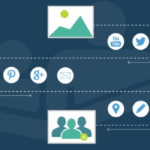Introduction
A. This section introduces the blog post topic, emphasizing the importance of online privacy in today’s digital landscape. It sets the stage for discussing 10 essential cybersecurity tips to protect one’s online privacy.
B. The introduction previews the 10 tips that will be covered in the blog post, giving readers an overview of what to expect.
Use Strong and Unique Passwords
A. Strong, complex passwords are crucial for protecting online accounts from unauthorized access. This tip highlights the importance of using unique passwords for each account to prevent security breaches.
B. Tips are provided for creating strong passwords that are difficult for hackers to guess. It also introduces the concept of password managers for securely managing passwords across multiple accounts.
C. The section emphasizes the importance of using password managers to generate and store strong passwords securely.
Enable Two-Factor Authentication (2FA)
A. Two-factor authentication (2FA) adds an extra layer of security to online accounts by requiring users to provide two forms of identification. This tip explains the benefits of enabling 2FA for enhancing account security.
B. Readers are guided through the steps for enabling 2FA on various online accounts and platforms. It also introduces authenticator apps and hardware tokens as options for implementing 2FA.
C. The section underscores the importance of using 2FA to protect sensitive accounts and data from unauthorized access.
Keep Software and Devices Updated
A. Regularly updating software, operating systems, and devices is essential for addressing security vulnerabilities and protecting against cyber threats. This tip highlights the importance of staying up-to-date with security patches.
B. Tips are provided for enabling automatic updates and staying informed about software updates to ensure that devices are protected against the latest security threats.
C. The section stresses the risks of using outdated software and devices and encourages readers to prioritize updating their systems regularly.
Be Wary of Phishing Attempts
A. Phishing attacks are a common tactic used by cybercriminals to steal sensitive information from unsuspecting users. This tip explains how phishing attacks work and how to recognize and avoid them.
B. Readers are provided with tips for identifying phishing emails, messages, and websites, including looking for red flags such as spelling errors and suspicious links.
C. The section emphasizes the importance of being cautious when sharing personal information online and provides steps for protecting sensitive information from phishing scams.
Secure Your Wi-Fi Network
A. Securing Wi-Fi networks is crucial for preventing unauthorized access and protecting against cyber threats. This tip highlights the importance of setting up strong Wi-Fi passwords and encryption protocols.
B. Tips are provided for configuring Wi-Fi networks securely, including using strong passwords, enabling encryption, and implementing additional security features such as MAC address filtering.
C. The section introduces Wi-Fi security features like MAC address filtering and guest networks as additional measures for securing Wi-Fi networks against unauthorized access.
Use Secure Connections (HTTPS)
A. Using secure connections when browsing the web is essential for protecting sensitive information from interception by cyber criminals. This tip explains the importance of HTTPS encryption for secure communication.
B. Readers are provided with tips for identifying secure websites with HTTPS encryption and ensuring that their online transactions are protected from eavesdropping.
C. The section introduces browser extensions for forcing HTTPS connections to ensure that users’ online activities are protected from interception by malicious actors.
Limit Personal Information Sharing
A. Being cautious about sharing personal information online is crucial for protecting privacy and reducing the risk of identity theft. This tip highlights the importance of minimizing personal information exposure on social media and other platforms.
B. Tips are provided for adjusting privacy settings on social media platforms to control who can see and access personal information. It also emphasizes the importance of being selective about what information is shared online.
C. The section discusses the risks of oversharing personal information online and provides steps for protecting sensitive information from unauthorized access and misuse.
Be Cautious When Using Public Wi-Fi
A. Public Wi-Fi networks pose security risks, including the potential for unauthorized access and interception of sensitive data. This tip explains the security risks associated with public Wi-Fi networks and how to stay safe when using them.
B. Readers are provided with tips for protecting their data when using public Wi-Fi, including using virtual private networks (VPNs) and avoiding sensitive transactions on public networks.
C. The section introduces mobile data tethering as a secure alternative to public Wi-Fi for accessing the internet on mobile devices while on the go.
Regularly Backup Your Data
A. Regularly backing up data is essential for protecting against data loss due to cyberattacks, hardware failures, or other disasters. This tip explains the importance of implementing a backup strategy to safeguard important files and documents.
B. Tips are provided for creating backups of data, including choosing reliable backup solutions, scheduling regular backups, and storing backups securely to prevent unauthorized access.
C. The section introduces cloud storage and automatic backup services as convenient options for securely storing backups and ensuring that data is protected against loss or corruption.
Educate Yourself About Cybersecurity
A. Staying informed about cybersecurity threats and best practices is essential for protecting online privacy and security. This tip highlights the importance of educating oneself about cybersecurity to identify and mitigate potential risks.
B. Tips are provided for staying updated on cybersecurity news and developments, including following reputable cybersecurity blogs and news sources, participating in online communities, and attending cybersecurity events and conferences.
C. The section introduces cybersecurity resources, online courses, and communities for continuous learning and encourages readers to take proactive steps to enhance their cybersecurity knowledge and skills.
Conclusion
A. The conclusion summarizes the 10 essential cybersecurity tips discussed in the blog post, emphasizing their importance for protecting online privacy and security.
B. Readers are encouraged to implement these tips to safeguard their personal information and reduce the risk of falling victim to cyber threats.
C. Final thoughts are provided on the importance of proactive cybersecurity measures for staying safe online and protecting sensitive information from unauthorized access and misuse.















